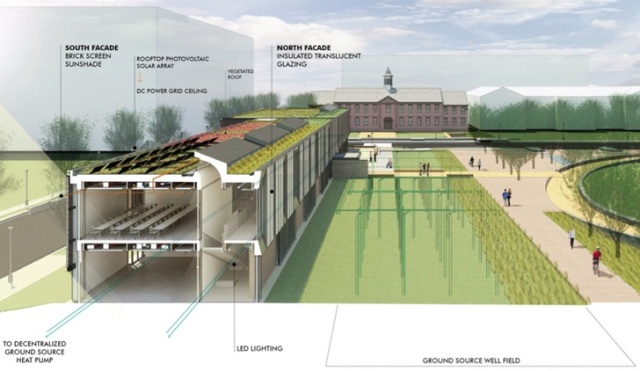Jan 20 2014
Work on a $39 million building project at The Navy Yard complex in Philadelphia will be completed by this fall, according to an update given to the Penn State Board of Trustees Committee on Finance, Business and Capital Planning today (Jan. 16).
 An artist's rendering of the Center for Building Energy Education and Innovation with the Center for Building Energy Science and Engineering in the background. The two projects are located across the street from each other at 12th Street and Kitty Hawk Avenue in The Navy Yard complex. Image: Penn State
An artist's rendering of the Center for Building Energy Education and Innovation with the Center for Building Energy Science and Engineering in the background. The two projects are located across the street from each other at 12th Street and Kitty Hawk Avenue in The Navy Yard complex. Image: Penn State
Ford Stryker, associate vice president for the Office of Physical Plant, said the project involves the renovation of a 38,000-square-foot structure into the Center for Building Energy Science and Engineering (CBESE), previously referred to in plans as “Building 661,” and the construction of a 25,200-square-foot facility called the Center for Building Energy Education and Innovation (CBEEI), previously referred to as “Building 7R.” Both buildings will be Leadership in Energy & Environmental Design (LEED) certified. The trustees approved the project at the January 2013 meeting.
The buildings will house The Navy Yard's Energy Efficient Buildings (EEB) Hub, a collective of researchers from academia, the private sector and national laboratories focused on saving energy, reducing greenhouse gas emissions and positioning the U.S. at the forefront of the energy-efficient building industry. The buildings will facilitate public education and outreach, and function as the EEB Hub headquarters.
“Penn State researchers were awarded grants totaling up to $159 million from several sources, primarily the Department of Energy and the Commonwealth of Pennsylvania, to develop ways to make commercial and multifamily residential buildings more energy efficient,” Stryker said.
Penn State leads the EEB Hub, the Department of Energy Mid-Atlantic Clean Energy Applications Center and other research and education programs at The Navy Yard. Martha Krebs was appointed senior scientist in Penn State’s College of Engineering and principal investigator and director of the EEB Hub, effective Dec. 1.
The 1,200-acre Navy Yard is home to 10,000 employees and 130 companies in a mix of historic buildings and new LEED-certified structures. In 1995, the military ceased nearly all U.S. Navy activities at the facility, which had been a site for Naval activity going back to the late 18th century.
Once the former Navy Yard recreation center, the CBESE has been unused since the base closed. Renovations include the main entrance and lobby. Conference rooms, offices and support spaces will be housed in the east portion of the building. The large sky-lit atrium will be used as an exhibition and event space, with bleacher-style stairs providing seating for lectures and demonstrations. Interior glass walls will provide views of the lighting, building controls and building information modeling labs. The second floor will house a 120-seat symposium space and an Immersive Construction (Icon) Laboratory.
The building’s more than 70-year-old roof and its pre-cast panel system were in poor condition and removed. This was not in the original plans and caused a five-week delay, according to Stryker. Completion of the CBESE is set for the summer.
The CBEEI will include research laboratories and technology demonstration spaces, as well as offices and state-of-the-art teaching facilities.
Unanticipated costs, such as the roof replacement, forced a scaling back of that project, Stryker said.
The three first-floor classrooms will be shell space, left unfinished for future use with only an exterior building shell. The plan originally called for only one classroom to be shell space. On the second floor, all four classrooms will be shell space; originally only two were to be shell spaces.
The foundation is complete, underground utility work is finished and drilling is done for the structure’s 44 geothermal wells. The project is expected to be finished in the fall.
The two projects are located across the street from each other at 12th Street and Kitty Hawk Avenue. Funding for the $39 million project comes from the state as well as grants from the U.S. Department of Energy and the Economic Development Administration.